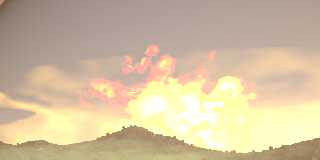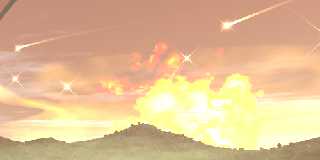 |
 |
|
 |
|
 |
|  |
|  |
|
 |
From: Thomas de Groot
Subject: Re: Early Earth: The Late Heavy Bombardment [final image]
Date: 13 Jul 2012 10:56:22
Message: <50003716@news.povray.org>
|
|
 |
|  |
|  |
|
 |
The best I can get at this stage (no good) using a differenced sphere
for the shock wave. Diffractions looks ok at the border but I cannot get
the transparency of the sphere right. The cloud layer is also
differenced (a tiny bit larger sphere) to ensure that no clouds are
present inside the shock wave.
Code snippet:
difference {
sphere {0, 1
hollow
texture {pigment {rgbt <1,1,1,1>} }
interior {
ior 1.1
media {
intervals 1
samples 10, 1000
scattering {1, 0.000025
extinction 1
}
}
}
}
sphere {0, 0.98
hollow
texture {pigment {rgbt <1,1,1,1>} }
interior {
ior 1.0
}
}
scale MediaScale * 1.52
translate <CamLoc.x, CamLoc.y, 5000> + <2800, 0, 0>
}
Thomas
Post a reply to this message
Attachments:
Download 'earlyearth - lhb.png' (114 KB)
Preview of image 'earlyearth - lhb.png'

|
 |
|  |
|  |
|
 |
From: Thomas de Groot
Subject: Re: Early Earth: The Late Heavy Bombardment [experimental image #2]
Date: 14 Jul 2012 04:01:22
Message: <50012752@news.povray.org>
|
|
 |
|  |
|  |
|
 |
Trying to get at the problem. I here switched off the sphere
representing the sky and the atmospheric media. Also corrected the shock
wave container as follows:
//start code
difference {
sphere {0, 1.00 hollow}
sphere {0, 0.98 hollow}
material {
texture {pigment {rgbt <1,1,1,1>} }
interior {
ior 1.1 //shock waved air
media {
intervals 1
samples 10, 1000
scattering {1, 0.0001
extinction 1
}
}
}
}
scale MediaScale * 1.52
translate <CamLoc.x, CamLoc.y, 5000> + <2800, 0, 0>
}
//end code
While one can see /inside/ the shock wave, it is not possible to see the
stars through the opposite end of the sphere... why?
Thomas
Post a reply to this message
Attachments:
Download 'earlyearth - lhb.png' (145 KB)
Preview of image 'earlyearth - lhb.png'

|
 |
|  |
|  |
|
 |
From: Thomas de Groot
Subject: Re: Early Earth: The Late Heavy Bombardment [experimental image #3]
Date: 14 Jul 2012 08:13:06
Message: <50016252@news.povray.org>
|
|
 |
|  |
|  |
|
 |
OK. Got the transparency solved. Just a stupid max_trace_level issue :-(
Next problem is to get rid of this sphere edge seen in cross section...
Thomas
Post a reply to this message
Attachments:
Download 'earlyearth - lhb_.png' (144 KB)
Preview of image 'earlyearth - lhb_.png'

|
 |
|  |
|  |
|
 |
From: clipka
Subject: Re: Early Earth: The Late Heavy Bombardment [experimental image #2]
Date: 14 Jul 2012 08:47:06
Message: <50016a4a$1@news.povray.org>
|
|
 |
|  |
|  |
|
 |
Am 14.07.2012 10:01, schrieb Thomas de Groot:
> While one can see /inside/ the shock wave, it is not possible to see the
> stars through the opposite end of the sphere... why?
max_trace_level maybe?
Post a reply to this message
|
 |
|  |
|  |
|
 |
From: clipka
Subject: Re: Early Earth: The Late Heavy Bombardment [experimental image #3]
Date: 14 Jul 2012 08:51:21
Message: <50016b49$1@news.povray.org>
|
|
 |
|  |
|  |
|
 |
Am 14.07.2012 14:12, schrieb Thomas de Groot:
> OK. Got the transparency solved. Just a stupid max_trace_level issue :-(
>
> Next problem is to get rid of this sphere edge seen in cross section...
... and here your real problems begin. You'll need to somehow mimic an
ior gradient.
Post a reply to this message
|
 |
|  |
|  |
|
 |
From: Alain
Subject: Re: Early Earth: The Late Heavy Bombardment [experimental image #3]
Date: 14 Jul 2012 20:03:20
Message: <500208c8$1@news.povray.org>
|
|
 |
|  |
|  |
|
 |
> Am 14.07.2012 14:12, schrieb Thomas de Groot:
>> OK. Got the transparency solved. Just a stupid max_trace_level issue :-(
>>
>> Next problem is to get rid of this sphere edge seen in cross section...
>
> ... and here your real problems begin. You'll need to somehow mimic an
> ior gradient.
Ugly cludge that can simulate an ior gradient:
Use many shells of decreasing thickness each varying in ior by a small
amount in the order of 0.002 or less.
The outer shell have an ior in the order of 1.001 or maybe even less,
then each other have a slightly larger ior.
Each thinner shells must reside inside any previous ones. No merge as
you need all those internal surfaces.
Big increase in rendering time and needs a large max_trace_level.
Alain
Post a reply to this message
|
 |
|  |
|  |
|
 |
From: Thomas de Groot
Subject: Re: Early Earth: The Late Heavy Bombardment [experimental image #2]
Date: 15 Jul 2012 03:11:19
Message: <50026d17$1@news.povray.org>
|
|
 |
|  |
|  |
|
 |
On 14-7-2012 14:46, clipka wrote:
> max_trace_level maybe?
I need to learn to count beyond five fingers... :-)
Thomas
Post a reply to this message
|
 |
|  |
|  |
|
 |
From: Thomas de Groot
Subject: Re: Early Earth: The Late Heavy Bombardment [experimental image #3]
Date: 15 Jul 2012 03:15:12
Message: <50026e00$1@news.povray.org>
|
|
 |
|  |
|  |
|
 |
On 15-7-2012 2:03, Alain wrote:
>> Am 14.07.2012 14:12, schrieb Thomas de Groot:
>>> Next problem is to get rid of this sphere edge seen in cross section...
>>
>> ... and here your real problems begin. You'll need to somehow mimic an
>> ior gradient.
>
> Ugly cludge that can simulate an ior gradient:
> Use many shells of decreasing thickness each varying in ior by a small
> amount in the order of 0.002 or less.
> The outer shell have an ior in the order of 1.001 or maybe even less,
> then each other have a slightly larger ior.
> Each thinner shells must reside inside any previous ones. No merge as
> you need all those internal surfaces.
>
>
> Big increase in rendering time and needs a large max_trace_level.
Hmm, yes, that might work. I leave that experiment for later though, as
I want to get on with my raytracing life ;-)
Would this be something for POV-Ray 4.0?
Thomas
Post a reply to this message
|
 |
|  |
|  |
|
 |
From: clipka
Subject: Re: Early Earth: The Late Heavy Bombardment [experimental image #3]
Date: 15 Jul 2012 10:30:36
Message: <5002d40c@news.povray.org>
|
|
 |
|  |
|  |
|
 |
Am 15.07.2012 09:15, schrieb Thomas de Groot:
> On 15-7-2012 2:03, Alain wrote:
>>> Am 14.07.2012 14:12, schrieb Thomas de Groot:
>>>> Next problem is to get rid of this sphere edge seen in cross section...
>>>
>>> ... and here your real problems begin. You'll need to somehow mimic an
>>> ior gradient.
>>
>> Ugly cludge that can simulate an ior gradient:
>> Use many shells of decreasing thickness each varying in ior by a small
>> amount in the order of 0.002 or less.
>> The outer shell have an ior in the order of 1.001 or maybe even less,
>> then each other have a slightly larger ior.
>> Each thinner shells must reside inside any previous ones. No merge as
>> you need all those internal surfaces.
>>
>>
>> Big increase in rendering time and needs a large max_trace_level.
>
> Hmm, yes, that might work. I leave that experiment for later though, as
> I want to get on with my raytracing life ;-)
>
> Would this be something for POV-Ray 4.0?
I'm not sure whether a dedicated feature would be able to significantly
reduce that render time.
Post a reply to this message
|
 |
|  |
|  |
|
 |
From: Alain
Subject: Re: Early Earth: The Late Heavy Bombardment [experimental image #3]
Date: 15 Jul 2012 18:58:12
Message: <50034b04$1@news.povray.org>
|
|
 |
|  |
|  |
|
 |
> Am 15.07.2012 09:15, schrieb Thomas de Groot:
>> On 15-7-2012 2:03, Alain wrote:
>>>> Am 14.07.2012 14:12, schrieb Thomas de Groot:
>>>>> Next problem is to get rid of this sphere edge seen in cross
>>>>> section...
>>>>
>>>> ... and here your real problems begin. You'll need to somehow mimic an
>>>> ior gradient.
>>>
>>> Ugly cludge that can simulate an ior gradient:
>>> Use many shells of decreasing thickness each varying in ior by a small
>>> amount in the order of 0.002 or less.
>>> The outer shell have an ior in the order of 1.001 or maybe even less,
>>> then each other have a slightly larger ior.
>>> Each thinner shells must reside inside any previous ones. No merge as
>>> you need all those internal surfaces.
>>>
>>>
>>> Big increase in rendering time and needs a large max_trace_level.
>>
>> Hmm, yes, that might work. I leave that experiment for later though, as
>> I want to get on with my raytracing life ;-)
>>
>> Would this be something for POV-Ray 4.0?
>
> I'm not sure whether a dedicated feature would be able to significantly
> reduce that render time.
It would require sampling along the ray path, determine the direction of
the ior gradient as well as it's value and deflect the ray accordingly.
In fact, you'll need to construct a spline that will describe the path
of each tracing ray through the object.
I don't think that it's unfeasible, but will be very computationaly
intencive and thus slow as hell. If the ior can be assumed to only
change relatively slowly, some interpolation and extrapolation may be
possible between rays that may help speeding thing. You'll need to use a
max_gradient just like in an isosurface.
With my cludge, you have the local normal and the ior is quantified into
discreete steps. It can be applyed to an isosurface by changing the
thressold. If applyed to a CSG object, the smaller versions need to have
individual components scalled separately from the whole object. Some
complexe primitives, like a julia_fractal or a some mesh, don't realy
support the needed scalling without self intersecting. A torus need to
have it's minor axis altered, but not it's major axis.
Heavy, potentialy memory hungry, SLOW, error prone, but should work.
With a sampling along the ray, you don't have any normal available to
help you and the ior may change in rather strange ways...
Alain
Post a reply to this message
|
 |
|  |
|  |
|
 |
|
 |
|  |




![]()